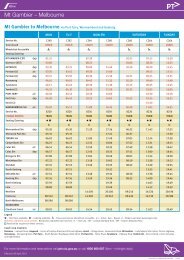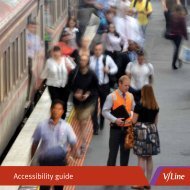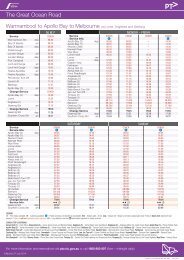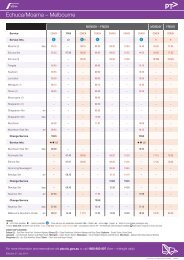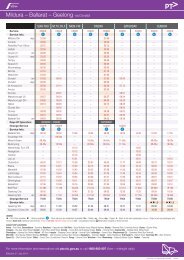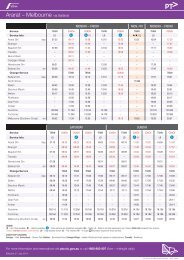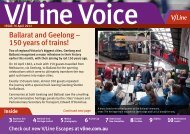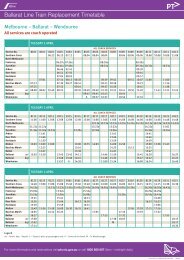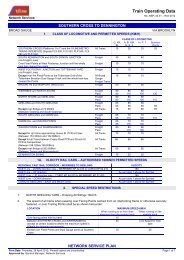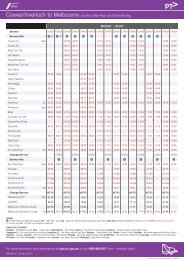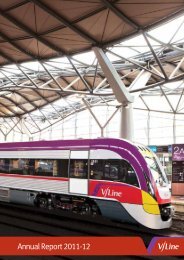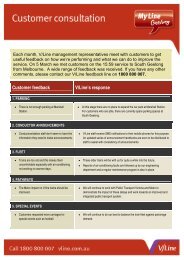ANNUAL REPORT 2004â05 - V/Line
ANNUAL REPORT 2004â05 - V/Line
ANNUAL REPORT 2004â05 - V/Line
- No tags were found...
Create successful ePaper yourself
Turn your PDF publications into a flip-book with our unique Google optimized e-Paper software.
NOTES TO THE FINANCIAL STATEMENTS1. Impairment of assets. AASB 136 Impairment of Assets requires assets to be assessed for indicators of impairment each year. This standardapplies to all assets, other than inventories, financial assets and assets arising from construction contracts, regardless of whether they are measured ona cost or fair value basis. If indicators of impairment exist, the carrying value of an asset will need to be tested to ensure that the carrying value does notexceed its recoverable amount, which is the higher of its value-in-use and fair value less costs to sell. For not-for-profit entities, value-in-use of an assetis generally its depreciated replacement cost.An impairment test was conducted on transition date, 1 July 2004, which indicated no impairment loss. It is not practicable to determine the impact ofthe change in accounting policy for future financial reports, as any impairment or reversal thereof will be affected by future conditions.2. Property, plant and equipment. When an asset is initially recognised, AASB 116 Property, Plant and Equipment requires the capitalisation ofcosts of dismantling and removing an asset and restoring the site on which the asset was created, together with the recognition of a provision at presentvalue in accordance with AASB 137 Provisions, Contingent Liabilities and Contingent Assets. These assets (and the related provisions) are notrecognised under Australian GAAP and any expenditure would be expensed as it was incurred. It is the Company's view that, due to the nature of theassets held, expenditure on dismantling and removing assets and restoring the site is unlikely to be incurred. As a consequence, there is not expected tobe an increase in depreciation expense as a result of any increase in the carrying amounts of assets and also no interest expense will be incurred as thepresent value discount on the dismantling provision unwinds.The impact of this change is expected to result in no change to the carrying amounts of assets and no recognition of a provision as at 30 June 2005.Accordingly, depreciation expense and interest expense are not expected to change for the year ended 30 June 2005.3. Employee Benefits. Under existing Australian accounting standards, employee benefits such as wages and salaries, annual leave and sick leaveare required to be measured at their nominal amount regardless of whether they are expected to be settled within 12 months of the reporting date. Onadoption of A-IFRS, a distinction is made between short-term and long-term employee benefits and AASB 119 Employee Benefits requires liabilities forshort-term employee benefits to be measured at nominal amounts and liabilities for long-term employee benefits to be measured at present value. AASB119 defines short-term employee benefits as employee that fall due wholly within twelve months after the end of the period in which the employeesrender the related service. Therefore, liabilities for employee benefits such as wages and salaries, annual leave and sick leave are required to bemeasured at present value where they are not expected to be settled within 12 months of the reporting date.For the year ended 30 June 2005, employee benefits expense is expected to decrease by $89K as the present value discount on the liabilities for longtermemployee benefits unwinds.4. Deemed Cost of Rolling Stock. AASB 16 (paragraph 15) states that an item of property, plant and equipment that qualifies for recognition as anasset shall be measured as its cost. Since the true historical cost of rollingstock is not ascertainable, the company/corporation has made an election, inaccordance with AASB 1, to use the fair value of rollingstock at 1 July 2004 as the deemed cost at that date.5. Financial Instruments. V/<strong>Line</strong> has elected to apply the first-time adoption exemption available under AASB 1 First-time adoption of AustralianEquivalent to International Financial Reporting Standard to defer the date of transition of AASB 139 Financial Instruments: Recognition and Measurementuntil 1 July 2005. Accordingly, there will be no quantitative impacts on the financial positions as at 1 July 2004 and 30 June 2005 and the financialperformance for the year ended 30 June 2005V/LINE <strong>ANNUAL</strong> <strong>REPORT</strong> 2004-05|69



